

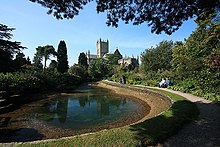
Wells St Andrew, or St Andrew Liberty, or derivations thereof, was a liberty, ecclesiastical parish, and later a civil parish, containing Wells Cathedral (which is dedicated to Saint Andrew) and surrounding land, in Somerset, England.



Wells St Andrew, or St Andrew Liberty, or derivations thereof, was a liberty, ecclesiastical parish, and later a civil parish, containing Wells Cathedral (which is dedicated to Saint Andrew) and surrounding land, in Somerset, England.
Bishop Jocelin established the area as a liberty, so as to be free from civil jurisdiction, in 1207. [3] The liberty was founded to provide housing for the canons of the cathedral, who were secular clergy. [3]
The Liberty encompassed 52 acres (21 ha) [4] broadly situated to the east of the city centre of Wells. [2] The main part of the Liberty formed a walled precinct within the city (which was otherwise not walled) [5] and this included Wells Cathedral, the Cathedral Green, the Bishop's Palace, the Old Deanery, and Vicars' Close. [2]
The Bishop's Palace was already surrounded by walls, but in 1286 Bishop Burnell obtained a licence to crenellate, so as to build gated walls around the wider cathedral close and adjacent residential complex of canons; [5] this licence was repeated in 1340 for Bishop Ralph of Shrewsbury. [5] [6] The building of the walls is believed to have filled a number of roles, including defending the ecclesiastical territory in a time of hostilities between religious and civic authorities, displaying the authority of the Bishop of Bath and Wells, and possibly also in part as an element in the landscaping of the cathedral close and palace. [5]
Access to this walled area was controlled by a number of gatehouses and other gateways; many of these buildings still exist: the Bishop's Eye, Brown's Gatehouse, the Chain Gate, the Penniless Porch (all four constructed under Bishop Beckington, c. 1450-60) [1] and the gateways at both ends of Vicars' Close. Much of the walls remain extant too, though in places have been reduced in height or have purposeful gaps. In places buildings formed the walled perimeter, especially facing the city centre; a notable gap in this built-up perimeter now exists opposite the Swan Hotel on Saddler Street, which allows for the hotel a direct view of the cathedral and a terrace by the Cathedral Green. [7]
The Liberty included further surrounding land and property owned by and with close connections to the cathedral, its bishop, and its clergy. Parts of the Liberty not within its walled precinct consisted of much the present-day site of the Wells Cathedral School, [8] as well as a small area of the city centre including the Town Hall, some surrounding buildings and down to the Bishop's Barn on Silver Street. [2] The Town Hall was originally the site of one of the canon's houses. [9]
The residents of the Liberty had specific rights in relation to seating in the cathedral and were exempt from contributing to the fees for upkeep of the city. The giving of alms to the poor attracted beggars into the Liberty which annoyed the residents in the 17th and 18th centuries. [10] There were also conflicts over jurisdiction between the Dean and Chapter of the Cathedral and the city authorities. [11]
Its population was recorded by national censuses carried out from 1801 to 1931, and during this period was generally between 300 and 400 residents. [12]
Wells St Andrew became a civil parish in 1866 [4] which subsequently merged in 1933 with Wells St Cuthbert In to form the present-day civil parish of Wells, [4] which covers all of the city; local government for Wells in this period was provided largely by Wells Municipal Borough.
The area of the former liberty retains a distinct character within the present-day city of Wells, [3] [9] and is still largely owned by the diocese, though with many areas open to the public (including the Bishop's Palace and gardens). [13] Through the northern part are streets named The Liberty (historically "North Liberty") [2] and East Liberty. [14] Ordnance Survey 1:25,000 maps continue to label the area with "St Andrew".
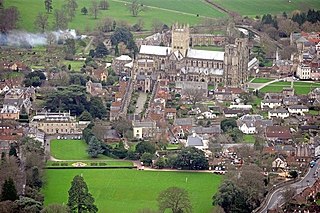
Wells is a cathedral city and civil parish in the Mendip district of Somerset, located on the southern edge of the Mendip Hills, 21 miles (34 km) south-east of Weston-super-Mare, 22 mi (35 km) south-west of Bath and 23 mi (37 km) south of Bristol. Although the population recorded in the 2011 census was only 10,536, and with a built-up area of just 3.244 km2 (1.253 sq mi), Wells has had city status since medieval times, because of the presence of Wells Cathedral. Often described as England's smallest city, it is actually second smallest to the City of London in area and population, but unlike London it is not part of a larger urban agglomeration.

Old Sarum, in Wiltshire, South West England, is the now ruined and deserted site of the earliest settlement of Salisbury. Situated on a hill about two miles north of modern Salisbury near the A345 road, the settlement appears in some of the earliest records in the country. It is an English Heritage property and is open to the public.

Lichfield Cathedral is an Anglican cathedral in Lichfield, Staffordshire, England, one of only three cathedrals in the United Kingdom with three spires, and the only medieval one of the three. It is the cathedral of the Diocese of Lichfield, which covers Staffordshire, much of Shropshire, and parts of the Black Country and West Midlands. It is the seat of the Bishop of Lichfield, currently Michael Ipgrave, who was appointed in 2016. It is a Grade I listed building.

Christ Church Cathedral, more formally The Cathedral of the Holy Trinity, is the cathedral of the United Dioceses of Dublin and Glendalough and the cathedral of the ecclesiastical province of the United Provinces of Dublin and Cashel in the (Anglican) Church of Ireland. It is situated in Dublin, Ireland, and is the elder of the capital city's two medieval cathedrals, the other being St Patrick's Cathedral.

Southwark Cathedral or The Cathedral and Collegiate Church of St Saviour and St Mary Overie, Southwark, London, lies on the south bank of the River Thames close to London Bridge. It is the mother church of the Anglican Diocese of Southwark. It has been a place of Christian worship for more than 1,000 years, but a cathedral only since the creation of the diocese of Southwark in 1905.

Wells Cathedral is an Anglican cathedral in Wells, Somerset, England, dedicated to St Andrew the Apostle. It is the seat of the Bishop of Bath and Wells, whose cathedra it holds as mother church of the Diocese of Bath and Wells. Built as a Roman Catholic cathedral from around 1175 to replace an earlier church on the site since 705, it became an Anglican cathedral when King Henry VIII split from Rome. It is moderately sized for an English cathedral. Its broad west front and large central tower are dominant features. It has been called "unquestionably one of the most beautiful" and "most poetic" of English cathedrals.

Chew Magna is a village and civil parish within the Chew Valley in the unitary authority of Bath and North East Somerset, in the ceremonial county of Somerset, England. The parish has a population of 1,149.

In Christianity, a collegiate church is a church where the daily office of worship is maintained by a college of canons: a non-monastic or "secular" community of clergy, organised as a self-governing corporate body, which may be presided over by a dean or provost. In its governance and religious observance a collegiate church is similar to a cathedral, although a collegiate church is not the seat of a bishop and has no diocesan responsibilities. Collegiate churches were often supported by extensive lands held by the church, or by tithe income from appropriated benefices. They commonly provide distinct spaces for congregational worship and for the choir offices of their clerical community.
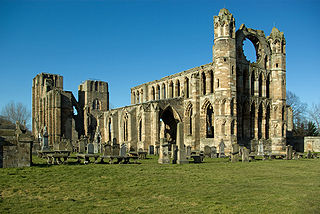
Elgin Cathedral is a historic ruin in Elgin, Moray, north-east Scotland. The cathedral—dedicated to the Holy Trinity—was established in 1224 on land granted by King Alexander II outside the burgh of Elgin and close to the River Lossie. It replaced the cathedral at Spynie, 3 kilometres (1.9 mi) to the north, that was served by a small chapter of eight clerics. The new and bigger cathedral was staffed with 18 canons in 1226 and then increased to 23 by 1242. After a damaging fire in 1270, a rebuilding programme greatly enlarged the building. It was unaffected by the Wars of Scottish Independence but again suffered extensive fire damage in 1390 following an attack by Robert III's brother Alexander Stewart, Earl of Buchan, also known as the Wolf of Badenoch. In 1402 the cathedral precinct again suffered an incendiary attack by the followers of the Lord of the Isles. The number of clerics required to staff the cathedral continued to grow, as did the number of craftsmen needed to maintain the buildings and surroundings.
Wells Cathedral School is a co-educational independent school located in Wells, Somerset, England. The school is one of the five specialist musical schools for school-age children in the United Kingdom, along with Chetham's School of Music, the Yehudi Menuhin School, the Purcell School and St. Mary's Music School, Edinburgh. The Head Master, Alastair Tighe, is a member of the Headmasters' and Headmistresses' Conference.
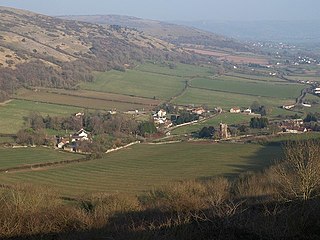
Compton Bishop is a small village and civil parish, at the western end of the Mendip Hills in the English county of Somerset. It is located close to the historic town of Axbridge. Along with the village of Cross and the hamlets of Rackley and Webbington it forms the parish of Compton Bishop and Cross.

Crediton Parish Church, formally the Collegiate Church of the Holy Cross and the Mother of Him who Hung Thereon, is a prominent building and worshipping community in the Devon town of Crediton. The church is built on the site of what was the "cathedral" of the Bishop of Crediton in the former diocese until 1050 when the see was transferred to Exeter. A college of canons remained at Crediton, administering the buildings and life of the "collegiate" church. The nave and chancel of the current building date from the 15th century. At the English Reformation the church was surrendered to Henry VIII in 1545, and the college dispersed. The church buildings were bought by the Crediton Town Corporation who still administer the fabric today. Now a parish church, the life of the church is administered by the parochial church council (PCC), although many still refer to the church as the Collegiate Church of the Holy Cross.
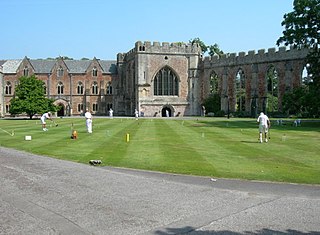
The Bishop's Palace and accompanying Bishops House at Wells in the English county of Somerset, is adjacent to Wells Cathedral and has been the home of the Bishops of the Diocese of Bath and Wells for 800 years. It has been designated by English Heritage as a Grade I listed building.

A cathedral close is the area immediately around a cathedral, sometimes extending for a hundred metres or more from the main cathedral building. In Europe in the Middle Ages, and often later, it was usually all the property of the cathedral, and under the bishop or cathedral's legal jurisdiction rather than that of the surrounding city. It normally had gates which were locked at night or when there were disturbances in the wider city, hence the name - "close" in the sense "something enclosed". It usually included buildings housing diocesan offices, schools, free-standing chapels associated with the cathedral, and the palace of the bishop and other clergy houses associated with the cathedral. Cathedral closes are sometimes - but not necessarily - arranged in a sort of square around a courtyard, as in the close at Salisbury Cathedral. The equivalent German term is Domfreiheit.
Mendip is a local government district in the English county of Somerset. The Mendip district covers a largely rural area of 285 square miles (738 km2) ranging from the Mendip Hills through on to the Somerset Levels. It has a population of approximately 11,000. The administrative centre of the district is Shepton Mallet.

The Penniless Porch in Wells, Somerset, England, is an entrance gateway into a walled precinct, the Liberty of St Andrew, which encloses the twelfth century Cathedral, the Bishop's Palace, Vicar's Close and the residences of the clergy who serve the cathedral. It has been designated as a Grade I listed building.
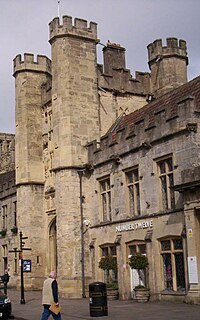
The Bishop's Eye in Wells, Somerset, England, is an entrance gateway into a walled precinct, the Liberty of St Andrew, which encloses the twelfth century Cathedral, the Bishop's Palace, Vicar's Close and the residences of the clergy who serve the cathedral. It has been designated as a Grade I listed building.
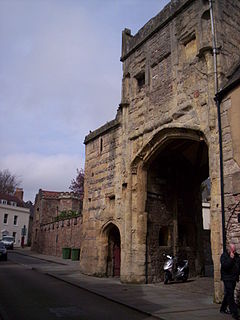
Brown's Gatehouse in Wells, Somerset, England, is an entrance gateway into a walled precinct, the Liberty of St Andrew, which encloses the twelfth century Cathedral, the Bishop's Palace, Vicar's Close and the residences of the clergy who serve the cathedral. Brown's Gatehouse has been designated as a Grade I listed building and Scheduled Ancient Monument.

Vicars' Close, in Wells, Somerset, England, is claimed to be the oldest purely residential street with original buildings surviving intact in Europe. John Julius Norwich called it "that rarest of survivals, a planned street of the mid-14th century". It comprises numerous Grade I listed buildings, comprising 27 residences, built for Bishop Ralph of Shrewsbury, a chapel and library at the north end, and a hall at the south end, over an arched gate. It is connected at its southern end to the cathedral by a walkway over Chain Gate.

Wells St Cuthbert In, sometimes St Cuthbert In, was a civil parish covering the larger part of the small city of Wells, in Somerset, England.